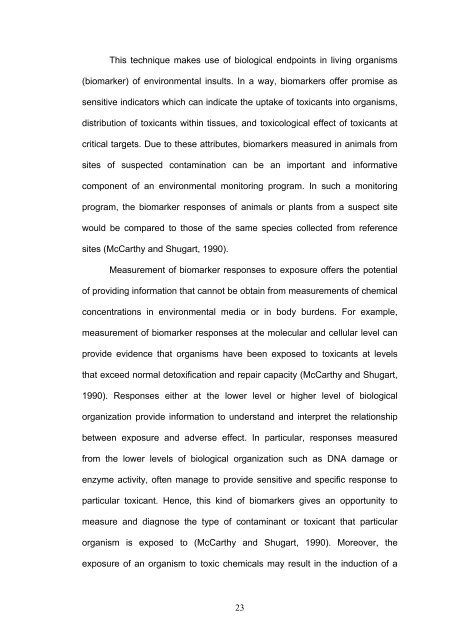IDENTIFICATION OF COPPER-INDUCIBLE GENES IN Pistia stratiotes
IDENTIFICATION OF COPPER-INDUCIBLE GENES IN Pistia stratiotes
IDENTIFICATION OF COPPER-INDUCIBLE GENES IN Pistia stratiotes
You also want an ePaper? Increase the reach of your titles
YUMPU automatically turns print PDFs into web optimized ePapers that Google loves.
This technique makes use of biological endpoints in living organisms<br />
(biomarker) of environmental insults. In a way, biomarkers offer promise as<br />
sensitive indicators which can indicate the uptake of toxicants into organisms,<br />
distribution of toxicants within tissues, and toxicological effect of toxicants at<br />
critical targets. Due to these attributes, biomarkers measured in animals from<br />
sites of suspected contamination can be an important and informative<br />
component of an environmental monitoring program. In such a monitoring<br />
program, the biomarker responses of animals or plants from a suspect site<br />
would be compared to those of the same species collected from reference<br />
sites (McCarthy and Shugart, 1990).<br />
Measurement of biomarker responses to exposure offers the potential<br />
of providing information that cannot be obtain from measurements of chemical<br />
concentrations in environmental media or in body burdens. For example,<br />
measurement of biomarker responses at the molecular and cellular level can<br />
provide evidence that organisms have been exposed to toxicants at levels<br />
that exceed normal detoxification and repair capacity (McCarthy and Shugart,<br />
1990). Responses either at the lower level or higher level of biological<br />
organization provide information to understand and interpret the relationship<br />
between exposure and adverse effect. In particular, responses measured<br />
from the lower levels of biological organization such as DNA damage or<br />
enzyme activity, often manage to provide sensitive and specific response to<br />
particular toxicant. Hence, this kind of biomarkers gives an opportunity to<br />
measure and diagnose the type of contaminant or toxicant that particular<br />
organism is exposed to (McCarthy and Shugart, 1990). Moreover, the<br />
exposure of an organism to toxic chemicals may result in the induction of a<br />
23








![[Consumer Behaviour] - ePrints@USM](https://img.yumpu.com/21924816/1/184x260/consumer-behaviour-eprintsusm.jpg?quality=85)








